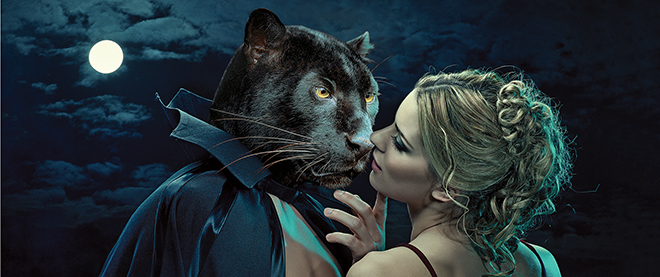A different sort of bump in the night
Who needs vampires when you can romance eagles, coyotes, even the odd ghost?
Photo illustration by Sarah MacKinnon
Share

After devouring Fifty Shades of Grey, a lot of readers must have looked around the erotica market and realized they could find plots a whole lot kinkier than that of a billionaire with a penchant for tying up his lover during sex. How about a man who is insatiable in bed, can turn into a wolf and also shares his lover with his other half? Or a bisexual dominant vampire warrior who, when not in a sex playroom even Christian Grey would envy, turns his beloved into a ghost?
“It’s definitely something readers were looking for,” says Cindy Hwang, a vice-president of Berkley Books, which, for more than a decade, has published erotica, including paranormals. These books—featuring stalwarts such as vampires and werewolves, as well as angels, aliens, shape-shifters, psychics, eagles, Bengal tigers and the odd coyote or two—have long been popular among erotica aficionados, but now they are getting their moment in the mainstream sun.
“Fifty Shades opened up this broader market and now they’re going, ‘Gee, I like it, I want more,’ ” says Raelene Gorlinsky, publisher of Ellora’s Cave, the world’s largest producer of erotic fiction, with a backlist of more than 4,500 titles, of which one-quarter are paranormal. Gorlinsky expects overall sales to increase by up to 30 per cent this year and sees a distinct uptick in interest in the paranormal genre.
Berkley, a Penguin imprint, is experiencing the same increased attention in its paranormals. In recent months, it redesigned and reissued the popular Breeds series created by bestselling writer Lora Leigh, whose books feature characters genetically infused with animal DNA. And the author’s first hardcover title centres around a lion named Rule Breaker. The 47-year-old grandmother of three—who enjoys an almost vampiric existence, waking just before sunset to write through the night—loves the freedom from conventional reality that comes with writing paranormals: “You can set it in any time and really make up your own rules.”
Since the characters in paranormals aren’t bound by the rules of nature, they are the ultimate sex gods. “You’re not stuck with the reality of how sex really works,” Gorlinsky explains. “A vampire can do it for 12 hours straight, if you want to write it that way. You don’t have to have recovery time in between.” The satyrs in Elizabeth Amber’s books not only love to have sex, but each grows a second penis every full moon, while Leigh’s male Breeds feature genitalia add-ons such as knots and barbs.
While paranormals have always walked a sexual precipice, the last decade has seen the entire romance industry race toward the cliff’s edge, the result of erotica—in which sex is integral to the story—growing acceptable to that wider market. It isn’t just books—HBO’s True Blood, say, with its twin obsessions of unbridled sex and otherworldly creatures including panthers and fairies, helped pave the way. This February, Jory Strong, author of 39 paranormal erotic stories, gave herself a vacation assignment: read the top choices in every genre of erotic romance in the industry bible, Romantic Times Book Reviews. “I couldn’t really tell anymore what’s mainstream romance and what’s erotic,” she concluded.
For the most part, paranormals don’t suffer from any such ambiguity. When couples hit the sheets in Emma Holly’s Demons series, for instance, a biological imperative makes lovemaking essential, while one of Opal Carew’s novels features a kidnapped woman, destined to marry an alien king, who first works her way through his bodacious spaceship crew.
The biggest problem for Susan Caron, the Toronto Public Library’s head of collection development, is finding enough books to satisfy demand, especially since the paranormal genre is so segmented. “Some readers are really wedded to one sub-genre,” she says. “Vampire readers don’t read about werewolves.”
Still, readers keep expanding their erotic horizons. “They’ll try paranormal, then, ‘Oh, ménage, let me try that,’ ” Gorlinsky says. “Try, as in, read—I’m not implying anything about their personal lives.”